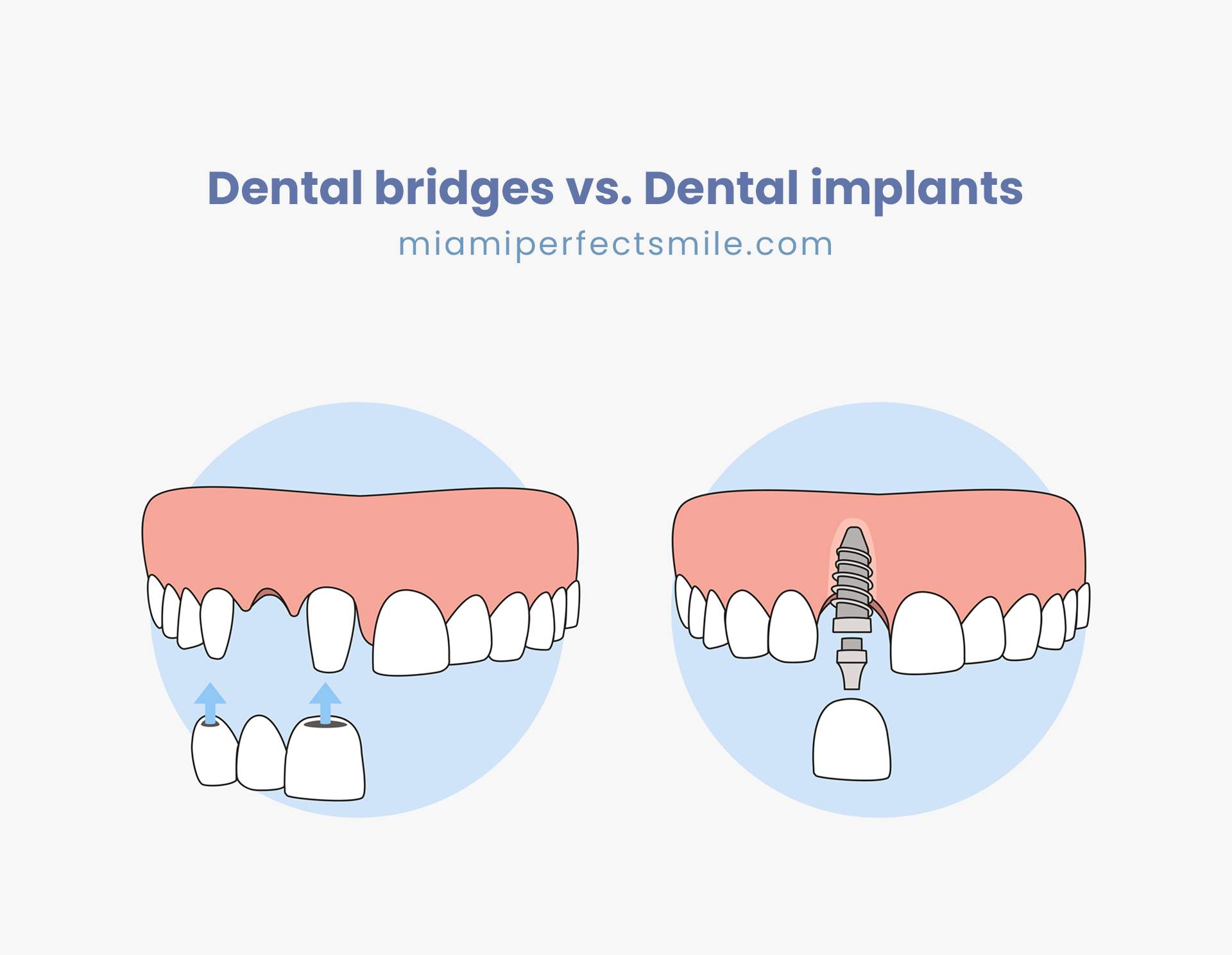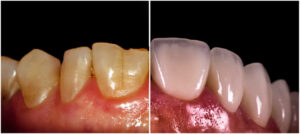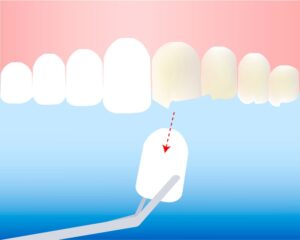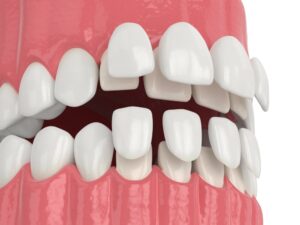Making a comparison of dental bridges vs. dental implants is important today. Dental bridges have been in use for quite some time now. But although dental implants are a more recent treatment, their resounding success has attracted the attention of researchers, dentists, and patients. There are specialists who do not hesitate to affirm that dental implants have become the procedure par excellence for oral recovery.
However, why haven’t dental bridges gone out of use? What are the differences between dental bridges and dental implants? These are questions that must be asked when deciding on one treatment or another. We know that decisions that affect oral health will be important regarding good quality of life. That is why in today’s post we will give you all the details about the comparison of dental bridges vs. dental implants.
You May Be Also Interested in: All possible problems with dental implants and their solutions
We want you to be aware of everything you need to know about these two techniques. To do this, we will examine what each of them consists of, how long they have been around, what their pros and cons are, and other points of interest. Towards the end, we will summarize all the content in comparative tables so that it is as practical as it is useful. We know that many of you were looking for this information!
We offer you the best prices for bridges and dental implants in Miami
If you are looking for a bridge treatment or dental implants in Miami, you have just come to the right place. At Miami Perfect Smile we make everything you need available to ensure you and your smile look renewed, fresh and healthy. In our center, you can get dental veneer treatments, smile designs, dental implants, and more. By following the link we just inserted, you can contact us or schedule your first appointment and find out everything you need. We’re here to serve you!
We use the best quality materials and state-of-the-art technology to give you an aesthetic and natural smile. Your well-being is our goal. In our facilities, you will receive the careful and specialized treatment that you deserve. Review the opinions of our patients and check their satisfaction with our treatment. Having satisfied patients is our best letter of introduction.

We accept all types of insurance with which you are covered. And something very important: our prices is reasonable if you compare them with those of other states in the country. You can investigate, and you will see our excellent relationship between quality and price. It is worth noting that many people travel to Florida to undergo dental implant treatment in Miami. Despite the travel expenses, our prices are still more affordable than those in other states.
Common goals of dental bridges and dental implants
Both dental bridges and dental implants are techniques that aim to solve the lack of partial or total teeth in patients. However, the methods used to carry this out, and the way in which they are later used are completely different. This is not to mention that for some people one technique will be more recommended than the other.
Dental bridges and dental implants share the same goal: to replace lost teeth. Replacing lost teeth provides patients with 3 fundamental benefits. These benefits, which are closely related to the natural functions of teeth, are:
1) Restore chewing function
Teeth are essential parts of our body since they allow us to maintain a normal life. The main function of the teeth is to fragment and grind food during the chewing process, which is the beginning of proper digestion. The incisor teeth serve to cut, the canines (popularly known as “fangs”) serve to tear, and the premolar and molar teeth serve to crush.
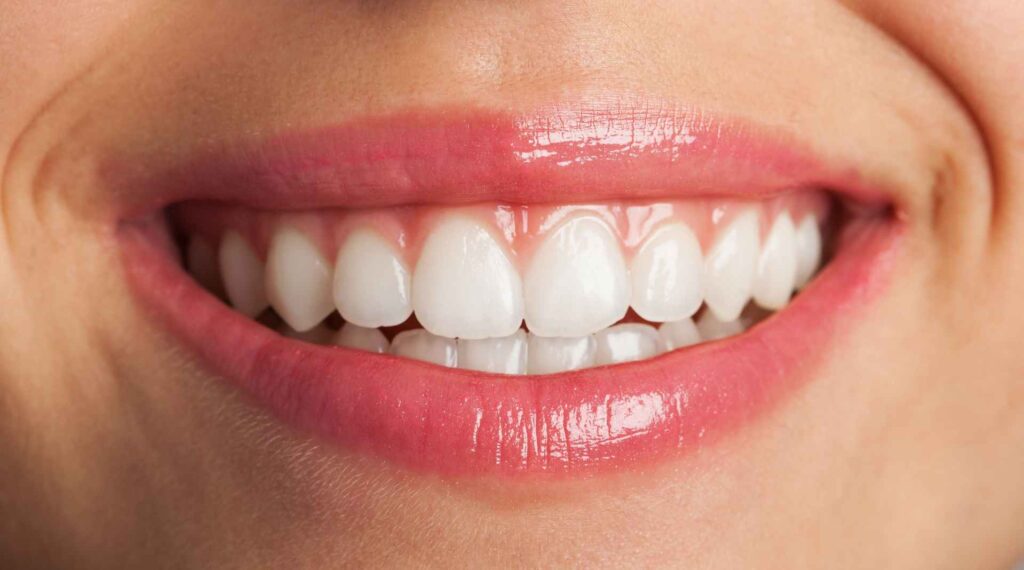
When there is a lack of teeth, or when the upper and lower jaws do not fit well, chewing function is affected. This means that the food cannot be crushed well, so digestion will be affected. Due to this, problems such as:
- Dyspepsia or slow metabolism : It is a disorder in which digestion slows down as a result of food reaching the stomach in larger pieces than required. During the normal chewing process, when teeth are not missing, saliva is generated and adheres to the food as it is chewed. In saliva there is a good amount of enzymes that, from the mouth, start the decomposition of nutrients. When you don’t chew enough because teeth are missing, the food reaches the stomach much more whole and with few salivary enzymes, which causes other organs to have to work harder to digest it. All of this leads to a slower metabolism.
- Aerophagia : This is an excess of gases, which can be produced in many cases by not chewing food well. These gases will be expelled in the form of repetitive belching and flatulence. In addition, they cause abdominal pressure, pain and intestinal noises.
- Weight gain : Not chewing food properly can cause you to eat more calories than you need, which can lead to excessive weight gain. Chewing well, on the other hand, helps stimulate the taste buds, which makes the feeling of fullness appear and the body feels satisfied without needing to consume excessive calories.
2) Recover correct phonetics
In addition to chewing, the teeth serve a unique function in speech and expression, which are two basic functions for human communication. Thanks to the teeth, correct pronunciation of words can be made. To achieve the articulation of speech sounds, we can say that the teeth are the passive elements, in relation to the lips and the tongue, which are the active ones. The teeth, lips and tongue constitute the articulating elements that participate in the modulation of sound and in the creation of the phonemes of speech.

3) Recover dental aesthetics
The third function of the dental organs is to maintain the aesthetics of the face. The lack of teeth can cause the face to change its appearance, to the point that the person feels bad about himself. For this reason, many patients suffer from psychological problems derived from not feeling comfortable with their teeth.
Situations such as fear of interacting with others, avoiding smiling, not wanting to speak so as not to open their mouth, avoiding leaving the house so that their sunken face is not seen, etc., usually occur to those who have lost a tooth. It can occur mostly with front teeth, but it also occurs with other teeth. For example, the absence of molars can cause the cheeks to become sunken. If the dental arches do not close properly, the symmetry of the face is affected. But it is true that if a front tooth is missing, it will be impossible to hide.
We have just seen the 3 common objectives of both dental treatments: dental bridges and dental implants. These characteristics allow both dental bridges and dental implants to form part of the group of techniques used in dentistry for dental rehabilitation through prosthetics. By replacing lost teeth thanks to either of these two techniques, the patient will be able to recover all the basic functions performed by the teeth. Herein lies the importance of both bridges and implants.
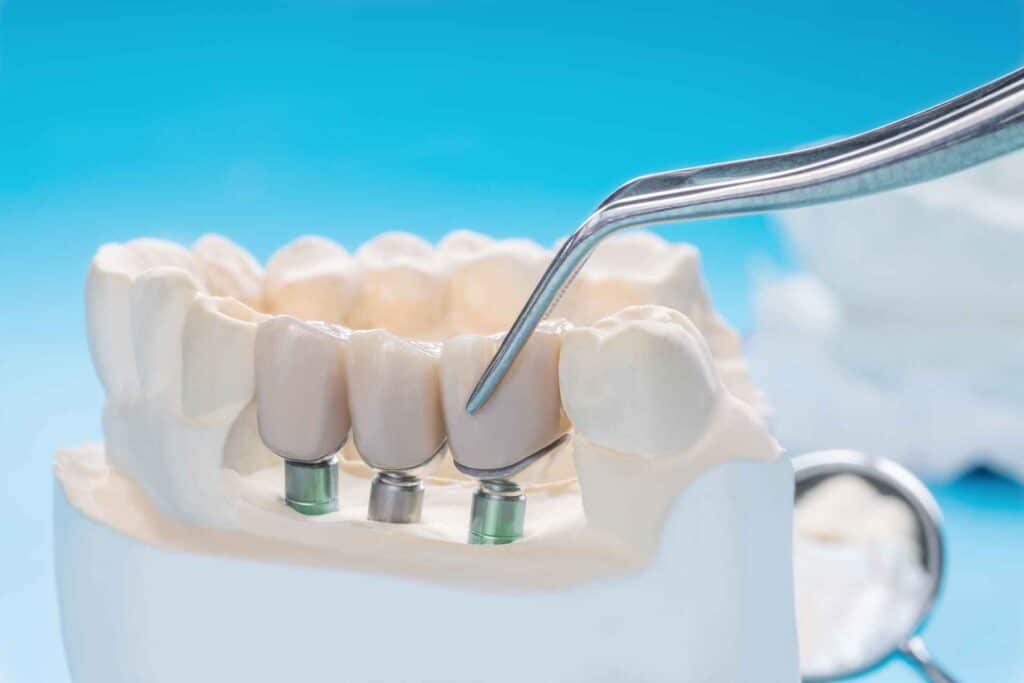
Dental bridges vs. dental implants: what does each one consist of?
Before being able to choose from the comparison of dental bridges vs. dental implants, we must thoroughly understand the characteristics of each one. For this, the first step is to examine what dental bridges are and what dental implants are. As we said above, bridges and dental implants have something in common, and that is that they are both treatments to solve the partial or total lack of teeth in patients. However, they also have substantial differences that distinguish them from each other.
What are dental bridges?
The dental bridge is an artificial structure that is made up of several dental crowns that simulate the shape of the teeth which are to be rehabilitated. The 2 crowns at the ends will be attached to natural teeth, while those that remain in the center are the ones that replace the missing tooth or teeth, and remain in the air, without attachment to the gum or bone other than the one that provides the crowns of the ends. These intermediate crowns are called pontics or false teeth. Generally, dental bridges are made of porcelain, although sometimes inert metals such as gold among others can be used. If planned and designed correctly, the dental bridge looks natural.
In order to fix the dental bridge, the natural teeth that are neighboring the space that has missing teeth must be considerably carved. These carved teeth will function as pillars since they will be the ones that will support the entire bridge. With carving, the volume of these two natural teeth is considerably reduced, so these teeth will cease to be functional forever. The pillars keep the bridge anchored and support the loads or pressures that occur when chewing.
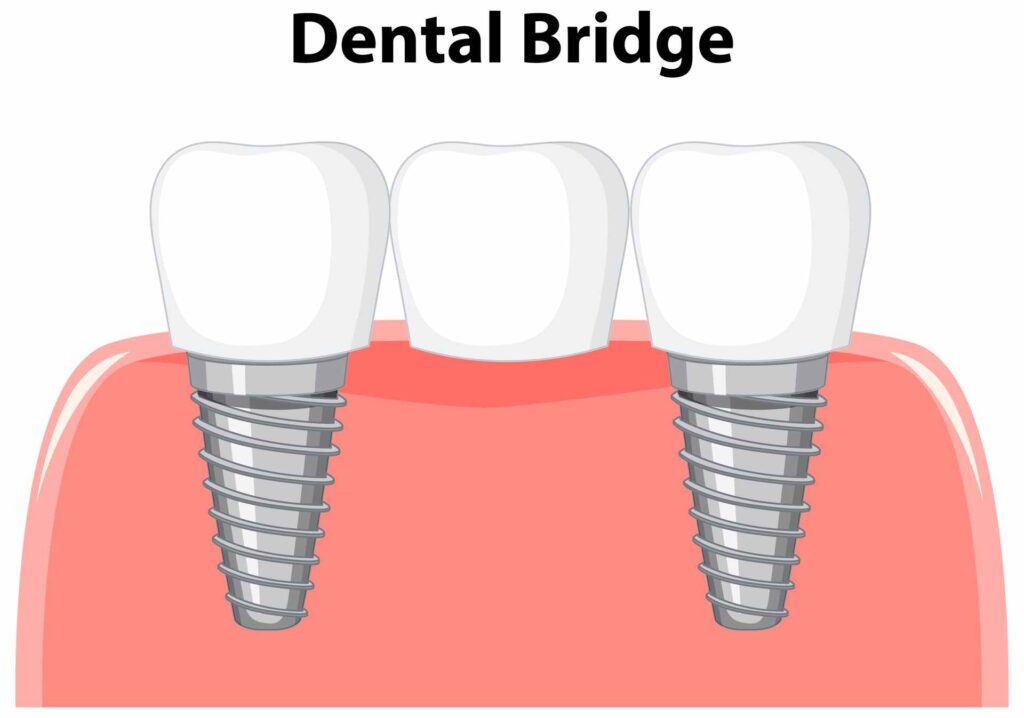
The pontic will be the empty space between the two abutment crowns. As we have said, it is the abutment crowns that support the entire bridge, since the pontics will be without direct support on the gum. In this way, the pontic restores the functionality of the space left by the missing teeth. Dental bridges can only be removed by the dentist since they will always be cemented and fixed.
Study and creation of the personalized dental bridge
When the patient decides on a dental bridge, the first thing that is done is the case studies. Each dental bridge is made in a personalized way, taking into account the shape of the teeth, the color, and the type of bite, among other aspects. For this, several studies are carried out, from which X-rays, photographs, and impressions will be made. All this information is used to create an exact mold of the patient’s mouth, on which the dentist will work in the planning and creation of the bridge.
Fitting a bridge is not a very complex process, since it is not necessary to perform surgery (which would be necessary to place implants). In fact, the entire process of creating the bridge, the preparation of the abutments and the fitting, can take as little as 2 weeks. The bridge also does not involve a recovery process and can be used from day one. Bridges are fairly inexpensive for most people, which is why they are highly sought after by patients. Dental bridges have a good quality-price ratio, thanks to which they are both an aesthetic and functional solution, as well as an economic one.
How long does a fixed dental bridge last?
Many patients frequently ask themselves: How long does a fixed dental bridge last? To this, we answer that the duration of dental bridges will depend on the care that is taken with them. Maintaining good daily hygiene will make the fixed dental bridge have a longer life since it will prevent the accumulation of dental plaque between the crown and the abutments. The weak point of dental bridges is that food can infiltrate the crowns and accumulate as debris at the base of the abutment teeth. This can decay the teeth and ruin the bridge.

Another important point for the fixed dental bridge to the last longer is to make frequent visits to the dentist, to examine the health of the bridge. It is even recommended that the dentist remove the bridge to do a thorough cleaning of the abutments and the prosthesis. Complying with these tips, the fixed dental bridge can last between 10 and 20 years. On the other hand, when there is not good dental hygiene on the part of the patient and the scheduled visits to the dentist are not made, the bridge can last between 5 and 10 years.
Types of dental bridges
There are several types of dental bridges, which are classified according to their shape and the way they are installed. They can also be made of various materials. The dentist will determine what type of dental bridge to use, depending on the conditions and needs of the patient. Among the types of dental bridges we have the following:
- Traditional dental bridges: These are the bridges that are placed when there are healthy teeth at both ends of the dental space which is to be repaired. On these, the crowns can be installed. Traditional bridges are the most effective types of dental bridges. Thanks to the fact that the crowns are cemented to the abutments (which are naturally worn teeth), the structure gains a lot of strength. This type of bridge provides great comfort when chewing because it distributes the force of the bite well.
- Cantilever dental bridges: This type of bridge is anchored on one side only, so it has 1 abutment and not 2 (unlike the traditional bridge we saw before). The advantage of this type of bridge is that it requires fewer natural teeth which are in good condition to be carved. However, it is not recommended to install this type of bridge in the back of the mouth, because the force of chewing could end up fracturing the abutment tooth.
- Maryland-type bridge: It is also known as a winged bridge. It consists of a pontic that has two lateral wings that are anchored on the inner face of the 2 adjacent healthy natural teeth. They are widely used to replace front teeth. Its main benefit is that the adjacent teeth hardly need any preparation, so they are preserved quite well.
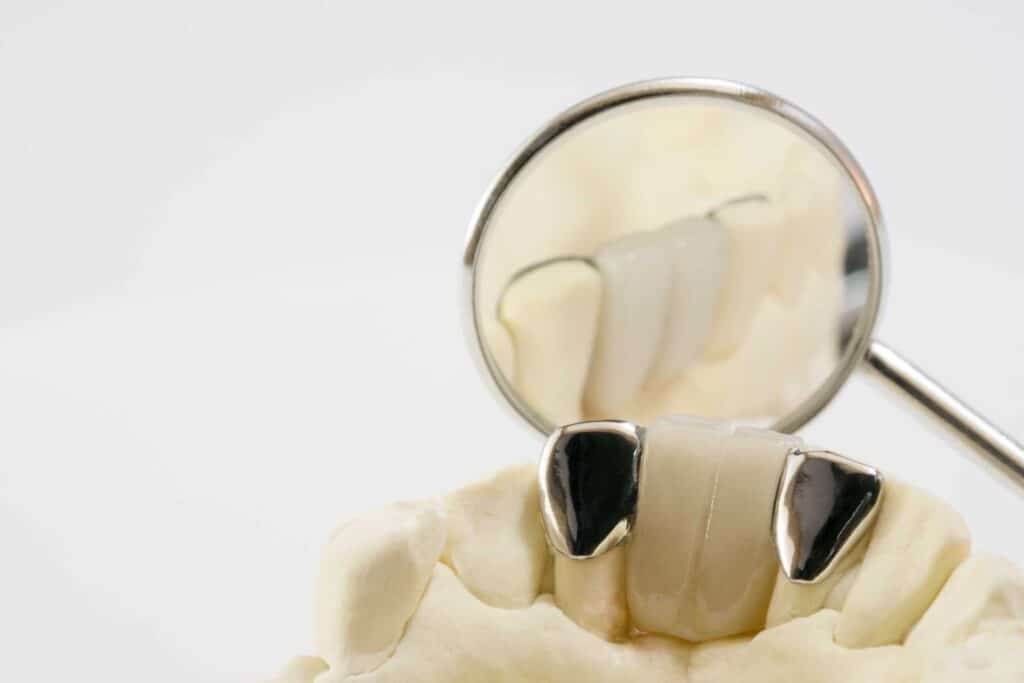
A portion of the medical literature on this subject considers dental bridges that are placed on implants to be a type of dental bridge. It would seem good to us to include them in the list that we have just seen. However, due to the characteristics of this article, we will leave bridges on implants as one of the types of oral restoration with dental implants, which we will look at right now, in the section after this one. In this way, we will make it easier for our readers to understand, so that in the end they will be able to compare dental bridges vs. dental implants whilst fully understanding the characteristics of both.
What are dental implants?
Dental implants are small metal pins that are inserted into the upper or lower jaw bone, in the space left by the dental root of a missing tooth. The objective of implants is to restore the lost tooth, thanks to the installation of dental prostheses on top of the implants. Dental implants generally have a screw-retained shape, which facilitates osseointegration with the bone.
To place dental implants, a surgical procedure is needed, which requires several steps prior to the operation, as well as a subsequent recovery period. However, the surgery itself is not complex. After 3 to 6 months from the installation, the implant will be perfectly anchored to the bone. It is at this point that it is ready to bear the full burden of denture use just as the roots of natural teeth do.
Although many patients wonder if dental implants hurt, the truth is that they do not hurt when they have already been perfectly integrated into the bone. In fact, worldwide statistics have shown that dental implants have very high success rates, which are around 95% (more than 98% according to some sources), whether they are placed in original bones or grafted. For this reason, dental implants are the most valuable and used therapeutic option for the partial or total replacement of teeth. The treatment of dental implants has been so successful globally, that investment in this field is expected to increase progressively.
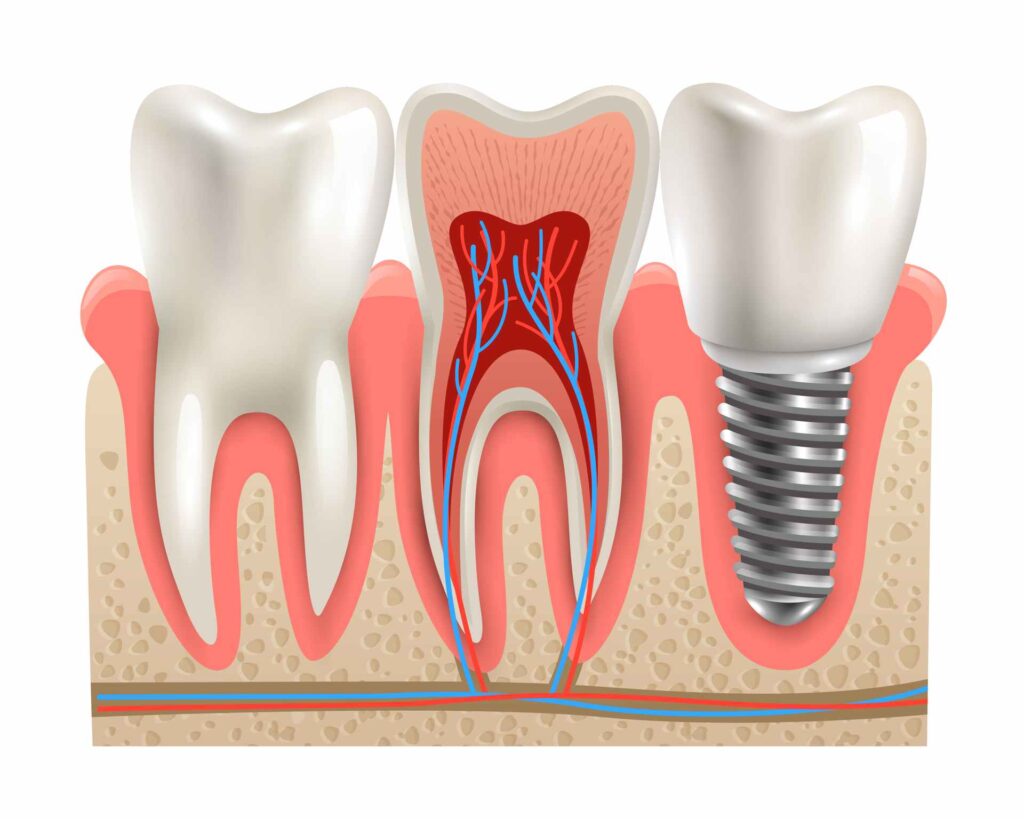
According to a report presented by Global Data (one of the leading companies in conducting market data studies and analysis), the annual growth rate for dental implant treatment will be 4.9%. By 2028, the global dental implant market is expected to reach $5.9 billion. In addition, it is expected that titanium implants will continue to be much more widely used than zirconium, although economic growth will benefit both dental implant materials.
Structure of dental implants
As we have said above, dental implants have a morphology similar to that of a pin or screw. Especially those made of titanium, which is the most used, due to their versatility. Implants are made up of 3 fundamental parts:
- Apical zone: This zone will act as a dental root, which is to give support and stability to the future prosthesis. The apical area will be inserted as deep as possible within the maxillary bone (lower or upper), although it must always avoid touching nerve endings. It has a rounded shape and is narrower than the rest of the implant, which favors an atraumatic introduction into the bone.
- Body: The body of the implant is its longest part. It is just between the apical area and the head or pillar. It usually has the same spiral structure as a screw, with the aim that the bone, when growing, adheres firmly to the implant. It is in the body of the implant where the important osseointegration process takes place, which will be essential for its proper functioning. The body of the implant remains completely within the maxillary bone.
- Head or pillar: The head or pillar is located above the gum and is made up of a small platform or connection area. It is on the pillar that the dental prosthesis or crown will be installed. The function of the head or abutment is to support the crown, bridge, or denture that is installed.
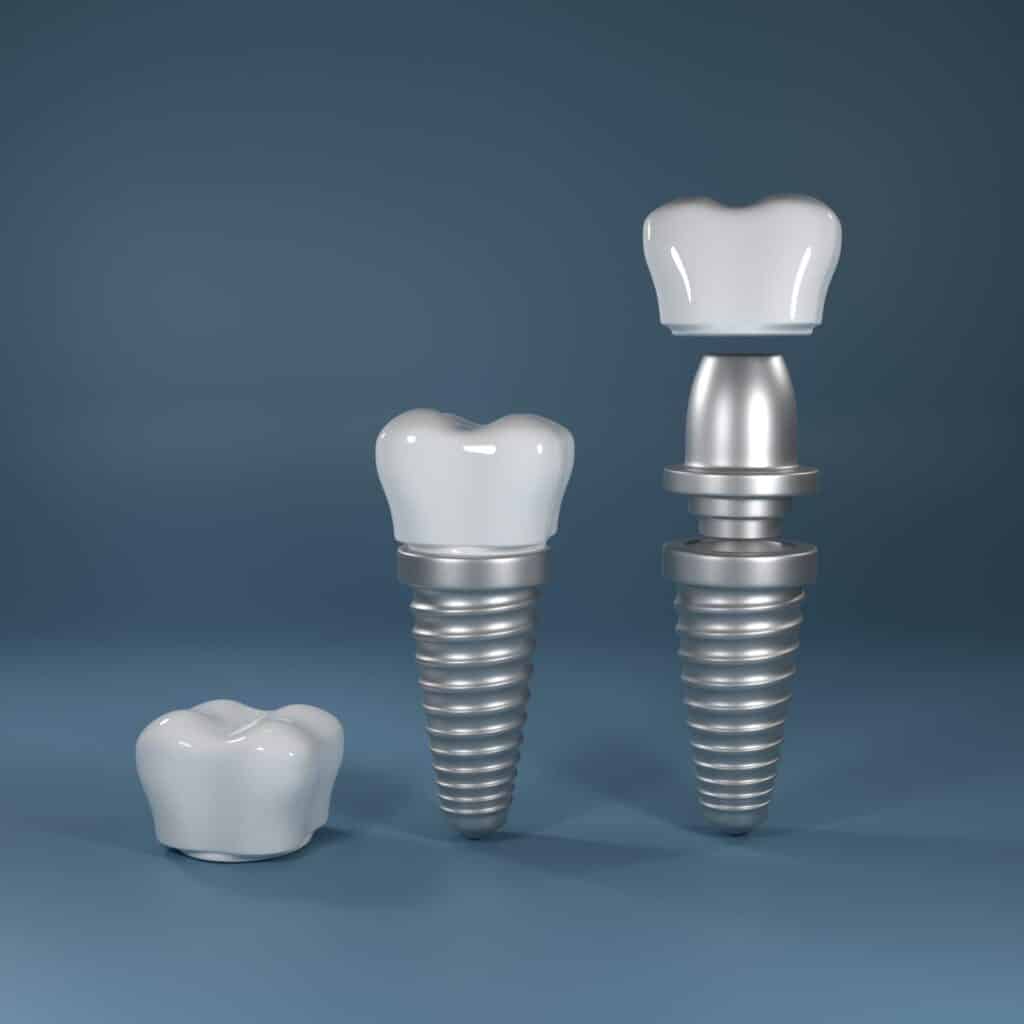
Types of dental prostheses that can be installed on dental implants
When the osseointegration process has been completed, the prosthesis is placed, which will rest on the implant. They can be:
- Individual crowns: These are generally metal, porcelain, or zirconia prostheses, which are placed on top of the dental implant abutment and come to replace a single missing tooth. Crowns are custom-made.
- Dental bridges: As we saw above, bridges can also be placed on implants. Only in this case, the bridge would take two dental implants as abutments, and not the carved natural teeth.
- Full dentures: These come to replace the entire upper or lower dental arch. In the all-in-four technique, this type of prosthesis can be installed, only using 4 implants as anchors. Dentures that are placed on dental implants can be permanent or mobile.
You May Be Also Interested in: All possible problems with dental implants and their solutions
Materials and versatility of dental implants
The vast majority of dental implants are made of titanium, which is an inert, versatile, high-strength, biocompatible metal that promotes osseointegration. However, there are patients who are allergic to other metals and, out of fear, reject titanium implants. Although there have been no reports of patients allergic to titanium, they are fitted with zirconium implants, which are less versatile, because they are not made up of two parts, unlike titanium ones.
Within the group of titanium implants, we find those that are made up of 2 parts, are the most desirable. Following the 2-part implant system, the implant is placed at bone level, so that the body of the implant is completely within the jawbone, while the upper part of the implant, which is the abutment, will be located above the gums. It is on the abutment that future crowns, bridges or dentures will be installed.
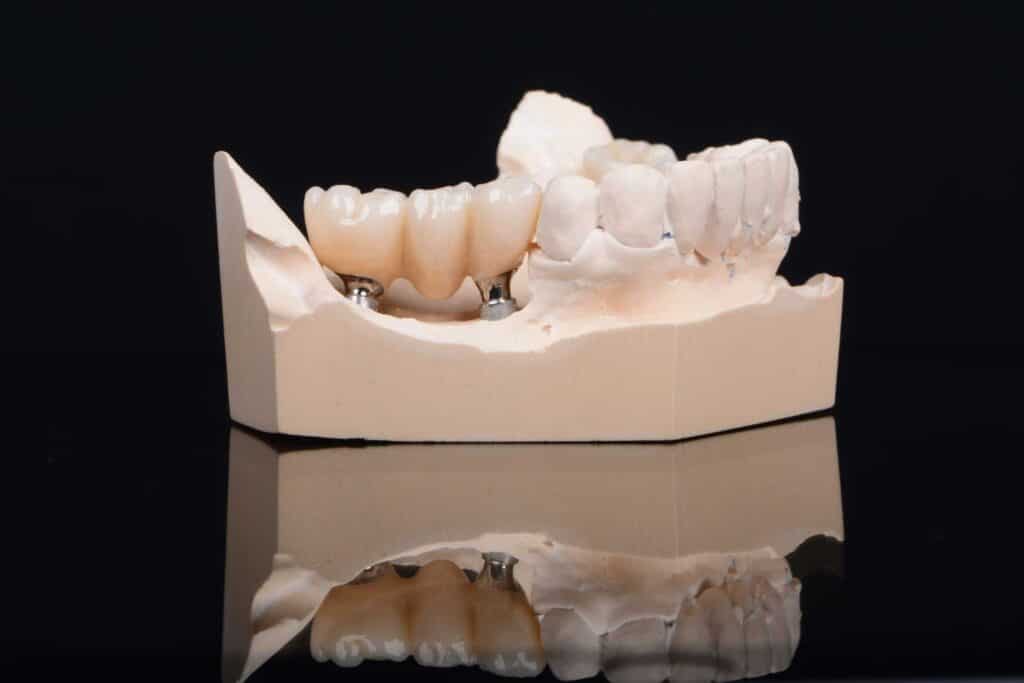
Types of dental implants
We have just looked at the types of dental implants according to their material. Below we will discuss, in a summarized way, what types of dental implants exist according to their shape and how to install them.
- Juxtaosseous or subperiosteal implants: They are placed between the maxillary bone and the gingival tissue. They are also known by the name fibro-integrated implants. They were the first models of dental implants that were used when implantology emerged. These types of implants provide good support for dental prostheses. Nowadays they have almost ceased to be used, because, being fixed between the tissue and the bone, they were prone to infections and could cause damage to the bone. However, they are still a good option for people who have problems with osseointegration, which is so necessary for endosseous implants, which are the next type.
- Endosseous or intraosseous implants: These are by far the most widely used implants today. They began to be manufactured in the 1970s when it was discovered that titanium had the biocompatible properties to integrate intimately and solidly with both maxillary bones. They are shaped like a pin or screw and are installed inside the bone, in the cavity left by the root of the missing tooth, as described above.

1) Comparative table of dental implants vs. bridges (pros and cons)
Now that we have seen what dental bridges and implants consist of, it is appropriate to discuss the advantages and disadvantages of each one. All health treatments have favorable points and other points that are not so favorable. It depends on the needs of each patient and their preferences, choosing one route or the other. Let’s examine the pros and cons of dental implants vs. bridges. This first table will offer new elements to elaborate on, a little later in this same article, we have a detailed comparison.
| COMPARATIVE TABLE OF DENTAL IMPLANTS VS. BRIDGE: PROS AND CONS | |
| PROS OF DENTAL BRIDGES | CONS OF DENTAL BRIDGES |
| They help to recover the chewing, phonetic and aesthetic function of the teeth. | They require carving the adjacent healthy teeth, which causes them to lose a lot of volume and all their enamel. |
| They are placed using a simple technique that does not require surgery. | They may require root canal treatment of ground teeth when, to obtain the proper size, the nerve or pulp space is invaded. |
| They are a fairly cheap and accessible treatment for most patients. | Leaks are generated by the lack of adjustment of the bridge with the carved teeth, which can cause cavities. |
| They have an acceptable aesthetic level, which imitates natural teeth quite well. | Atrophy of the maxillary bone occurs in the area of the gum that is covered by the cantilever or pontic teeth. |
| The procedure is done quickly. In about 2 weeks the patient can have the bridge installed. | When one of the pillars that supports the bridge fails, the whole made up of all the other pieces fails. |
| They do not require recovery time. | It can only be put into practice if there are teeth to support the bridge, so in many cases, it is not a possible treatment option. |
| PROS OF DENTAL IMPLANTS | CONS OF DENTAL IMPLANTS |
| They help to recover the chewing, phonetic and aesthetic function of the teeth. | They require surgery, which in many cases entails a long period of study and preparation. |
| It does not affect the health of existing teeth, as no grinding or volume reduction is required for installation. | A long post-surgical recovery time, between 3 and 6 months, is needed to achieve osseointegration of the implants in the bone. |
| It is a very long-lasting treatment, which can last for many years when good osseointegration is achieved. | Economically, it is a much more expensive treatment than dental bridges, so it is not available to many patients. |
| The implant supports the bone, which prevents atrophy of the maxilla from occurring. | It requires certain health conditions on the part of the patient in order to be carried out successfully. |
| It allows the installation of all types of prostheses: crowns, bridges, or complete dentures. | It is not viable in patients who need to frequently consume certain types of medication. |
| They have the highest aesthetic and functional levels. | The treatment requires a certain amount and quality of bone in the maxilla (upper or lower) so that the implants can be installed. |
2) General comparative table between dental bridges vs. dental implants
In this second table, we will address the comparison between dental bridges vs. dental implants from a more general perspective. The table exposes the characteristics of both methods of oral rehabilitation through certain comparative parameters.
| GENERAL COMPARISON TABLE DENTAL BRIDGES VS. DENTAL IMPLANTS | ||
| POINT TO COMPARE | DENTAL BRIDGES | DENTAL IMPLANTS |
| DURABILITY | They have an average duration of 5 to 10 years. When taken care of very well and with frequent visits to the dentist, they can last up to 20 years. | They can last a lifetime if they are properly maintained and if the patient does not present with any disease that compromises the osseointegration of the implant. |
| PRICE | It is a cheaper treatment. Its price ranges between $800 and $1000 for each tooth in the bridge. | It is a much more expensive treatment. Each implant can cost between $2,500 and $6,000 to install. |
| TREATMENT DURATION TIME | The bridge takes about 2 weeks to be ready and installed. This time also includes the period of previous studies. | Dental implant treatment can take no less than 3 to 6 months, which is the time it takes for the implant to anchor to the bone. This is without counting the period of previous studies and preparation (in case a dental root has to be extracted to open the space for the implant or to make a bone graft). Depending on each patient, in total it can take from 3 to 12 months. |
| RECOVERY | They do not need recovery time. They can be used from the moment they are installed. | They need a long recovery time after surgery to achieve healing and osseointegration of the implant in the bone. |
| INSTALLATION METHOD | They are easily installed, without the need for surgery, using the adjacent natural teeth as bridge abutments. | They always require a surgical process for their installation. |
| AFFECTATION OF DENTAL PIECES | Traditional bridges always involve the carving of adjacent teeth for their installation. This causes those 2 teeth to lose almost all their volume and remain without enamel, so they can never be used again without a crown. | It is not necessary to modify any of the dental pieces for its installation. |
| ESTHETIC | They have a medium to high aesthetic level, depending on the quality of the materials and the workmanship. | They have a high level of aesthetics, which mimics natural teeth almost perfectly. |
| BONE LOSS OR ATROPHY | The area of the bridge that will be covered by the pontics or flying teeth will suffer atrophy of the maxillary bone. This is because the lack of a dental root causes the bone tissues to absorb. | Because the dental implant will act as a dental root when it is installed inside the maxillary bone, bone loss or atrophy does not occur in this procedure. |
| COMFORT | They are comfortable and practical, almost like natural teeth. Especially those that are cemented with crowns on the dental abutments at both ends of the bridge. | They are very comfortable and practical as if they were your natural teeth. |
| INSURANCE COVERAGE | The treatment is covered by most dental insurance plans. | Not all dental insurance plans cover them, and others do so only partially. |
| HYGIENE | They require careful hygiene of 3 tooth brushings a day, which includes paying special attention to the area under the bridge, to avoid inflammation of the gums and teeth. It also requires visits to the dentist from time to time, to examine the condition of the pillars and that there are no leaks. | It requires normal hygiene to prevent food debris from accumulating around the implant abutments. If the prosthesis is removable, it should be washed daily. If the prosthesis is fixed, you have to go to the dentist from time to time to remove it and perform deep cleaning. Also during the visits, the health status of the dental implants will be examined. |
| DIETARY REQUIREMENTS | You do not need a special diet. However, patients should avoid biting into hard foods that can break the bridge or fracture the abutments. | You do not need a special diet. However, patients should avoid biting into hard foods that can break the prosthesis or fracture the implants. |
